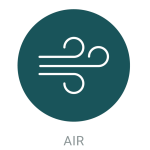“Clean air is a critical component to our health. Air pollution is the number one environmental cause of premature mortality, contributing to 50,000 premature deaths annually in the United States and approximately 7 million, or one in eight premature deaths worldwide.”
– WELL Building Standard v1 Reference Guide, Air
Outdoor air quality is gradually deteriorating around the globe due to traffic, construction, agricultural activity, combustion sources, and particulate matter. Additionally, our indoor air quality is polluted by off-gassing of building materials, indoor combustion sources, water leaks, poor ventilation, and airborne germs.
On average we spend 90% of our day indoors, and we typically breathe more than 15,000 liters of air every day. How many of us are currently aware of what is in the air we breathe? How about the impacts of these air contaminants on our health?


Health and Well-Being in the Built Environment, Concept 1: Air
Issue: According to the U.S. Environmental Protection Agency (EPA), levels of indoor air pollutants are often 2 to 5 times higher than outdoor levels, and in some cases can exceed 100 times that of outdoor levels of the same pollutants. Major pollutants to consider are Volatile Organic Compounds (VOCs), particulate matter, formaldehyde, carbon monoxide, ozone, and Radon.
Health Implications: Asthma, irregular heartbeat, Legionella infection, decreased lung function, nonfatal heart attacks, headaches, dry throat, eye irritation, runny nose, and premature death in people with heart or lung disease.
Solutions: We can improve the air quality of buildings through strategies such as enhanced ventilation, pollution filtration, minimizing mold growth potential, and monitoring of air quality.
WELL v2 Standard’s Recommended Strategies:
- Meeting or exceeding ASHRAE 62.1 guidelines for ventilation
- Utilizing CO2monitoring and demand-controlled ventilation
- Meet air quality thresholds for Particulate Matter, Radon, Organic gases, and Inorganic gases
- Choosing filters based on the quality of outdoor air available, with minimum required filtration ranging from MERV 8 to MERV 16 depending on location
- Operable windows are encouraged where there is high-quality outdoor air
- Implementing displacement ventilation and advanced air distribution strategies
- Prohibiting indoor and outdoor smoking
- Mitigating construction pollution
- Conducting system balancing every 5 years to ensure ventilation effectiveness
- Implementing Envelope commissioning and walk-off mats to reduce transmission of air pollutants from outdoors to indoors
- Limiting indoor combustion sources as much as possible
- Isolating and/or utilizing exhaust fans for rooms with high sources of odors, germs, pollution, or humidity – such as bathrooms, copy rooms, or chemical storage rooms
- Implementing carbon filtration to reduce indoor levels of VOCs
- Mold management via the usage of ultraviolet air treatment, condensation management, and mold inspections
- Air quality monitoring to address any performance issues and demonstrate the success of these design strategies
Summary
Consumption of high-quality air can significantly improve our overall health, well-being, and cognitive performance. If you or a loved one are ever experiencing respiratory issues or asthma, make sure to consider the quality of air you are consuming in your home or other frequently occupied buildings.
Although we consume massive amounts of air every day, we are typically unaware of the quality of air we are breathing, and the health impacts associated with this consumption. By monitoring our air quality and designing spaces with adequate ventilation, healthy materials, and effective pollution management in mind, we can improve the health, well-being, and quality of life for ourselves, our families, and our society.
Hero image at top of page:
Post HTX | OMA + Powers Brown Architecture + Hoerr Schaudt | Houston, Texas

